Book contents
- Frontmatter
- Contents
- Introduction
- Notes to Introduction
- DIVERS VOYAGES AND NORTHERNE DISCOVERIES
- Divers voyages and northerne discoveries of that worthy discoverer Henry Hudson, from Purchas' Pilgrims, vol. iii, pp. 567-610
- First Voyage, his discoverie towards the north pole in 1607, written partly by John Playse, one of the crew, and partly by Hudson himself
- Second Voyage or employment of Master Henry Hudson in 1608, written by himself
- Third Voyage of Master H. Hudson in 1609, written by Robert Juet of Limehouse
- Fourth Voyage in 1610. An Abstract of the Journal of Master Henry Hudson
- A larger Discourse of the same Voyage and the success thereof, written by Abacuk Pricket
- A note found in the deske of Thomas Wydowse, student of mathematics, one of them who was put into the shallop
- Purchas his Pilgrimage, folio, London, 1626, p. 817. VI. Of Hudson's discoveries and death
- Hudson's first voyage (1607), from Edge's brief discoverie of the Muscovia merchants
- Captain Fotherby's statement concerning Hudson's Journal of his first voyage
- Hudson's third voyage (1609) from Van Meteren's Historie der Nederlanden. Folio, Hague, 1614, fol. 629a
- Extracts relating to Hudson's third voyage (1609), from John de Laet's Nieuwe Werelt, fol., Amsterdam, 1625, 1630-1
- Extracts containing some original information about Hudson's third voyage, from Mr. Lambrechtsen van Ritthem's ‘History of New Netherland’
- Extracts concerning Hudson's third voyage (1609), from Adrian van der Donck's ‘Beschryvinge van Nieuw Nederlandt,’ 4to., Amsterdam, 1655, 1656
- American traditions concerning the third voyage (1609)
- An Extract from Captain Luke Foxe's description of Hudson's fourth voyage (North-West Fox) p. 70
- Hessel Gerritz's various accounts of Hudson's two last voyages, from the Latin and Dutch edition of the ‘Descriptio et Delineatio Geographica detectionis Freti ab H. Hudsono inventi.’ Amst., 1612, 1613: I. Hudson's fourth voyage. A summary printed on the back of the chart. An account of the voyage and new found strait of Mr. Hudson
- APPENDIX
- Index
- Plate section
First Voyage, his discoverie towards the north pole in 1607, written partly by John Playse, one of the crew, and partly by Hudson himself
Published online by Cambridge University Press: 05 August 2011
- Frontmatter
- Contents
- Introduction
- Notes to Introduction
- DIVERS VOYAGES AND NORTHERNE DISCOVERIES
- Divers voyages and northerne discoveries of that worthy discoverer Henry Hudson, from Purchas' Pilgrims, vol. iii, pp. 567-610
- First Voyage, his discoverie towards the north pole in 1607, written partly by John Playse, one of the crew, and partly by Hudson himself
- Second Voyage or employment of Master Henry Hudson in 1608, written by himself
- Third Voyage of Master H. Hudson in 1609, written by Robert Juet of Limehouse
- Fourth Voyage in 1610. An Abstract of the Journal of Master Henry Hudson
- A larger Discourse of the same Voyage and the success thereof, written by Abacuk Pricket
- A note found in the deske of Thomas Wydowse, student of mathematics, one of them who was put into the shallop
- Purchas his Pilgrimage, folio, London, 1626, p. 817. VI. Of Hudson's discoveries and death
- Hudson's first voyage (1607), from Edge's brief discoverie of the Muscovia merchants
- Captain Fotherby's statement concerning Hudson's Journal of his first voyage
- Hudson's third voyage (1609) from Van Meteren's Historie der Nederlanden. Folio, Hague, 1614, fol. 629a
- Extracts relating to Hudson's third voyage (1609), from John de Laet's Nieuwe Werelt, fol., Amsterdam, 1625, 1630-1
- Extracts containing some original information about Hudson's third voyage, from Mr. Lambrechtsen van Ritthem's ‘History of New Netherland’
- Extracts concerning Hudson's third voyage (1609), from Adrian van der Donck's ‘Beschryvinge van Nieuw Nederlandt,’ 4to., Amsterdam, 1655, 1656
- American traditions concerning the third voyage (1609)
- An Extract from Captain Luke Foxe's description of Hudson's fourth voyage (North-West Fox) p. 70
- Hessel Gerritz's various accounts of Hudson's two last voyages, from the Latin and Dutch edition of the ‘Descriptio et Delineatio Geographica detectionis Freti ab H. Hudsono inventi.’ Amst., 1612, 1613: I. Hudson's fourth voyage. A summary printed on the back of the chart. An account of the voyage and new found strait of Mr. Hudson
- APPENDIX
- Index
- Plate section
Summary
Anno 1607, Aprill the nineteenth, at Saint Ethelburge, in Bishops Gate street, did communicate with the rest of the parishioners these persons, seamen, purposing to goe to sea foure dayes after, for to discover a passage by the North Pole to Japan and China. First, Henry Hudson, master. Secondly, William Colines, his mate. Thirdly, James Young. Fourthly, John Colman. Fiftly, John Cooke. Sixtly, James Beubery. Seventhly, James Skrutton. Eightly, John Pleyce. Ninthly, Thomas Baxter. Tenthly, Richard Day. Eleventhly, James Knight. Twelfthly, John Hudson, a boy.
The first of May, 1607, we wayed anchor at Gravesend, and on Tuesday, the sixe and twentieth day, in the morning, we made the lies of Shotland, and at noon we were in 60 degrees 12 minutes, and sixe leagues to the eastward of them: the compass had no variation. We had sixty-foure fathomes at our sounding, blacke, ozie, sandie, with some yellow shels. Our ship made more way than we did suppose. On Saturday, the thirtieth of May, by our observation we were in 61 degrees 11 minutes. This day I found the needle to incline 79 degrees under the horizon. For foure days space we made very little way by contrary winds.
On Thursday, the fourth of June, we were, by our observation, still in 61 degrees and 14 minutes, eight and twentie or thirtie leagues from the norther part of Shotland: the land bearing by our accompt east and by north off us. I found variation in five degrees westerly.
- Type
- Chapter
- Information
- Henry Hudson the NavigatorThe Original Documents in which his Career is Recorded, pp. 1 - 22Publisher: Cambridge University PressPrint publication year: 2010First published in: 1860



